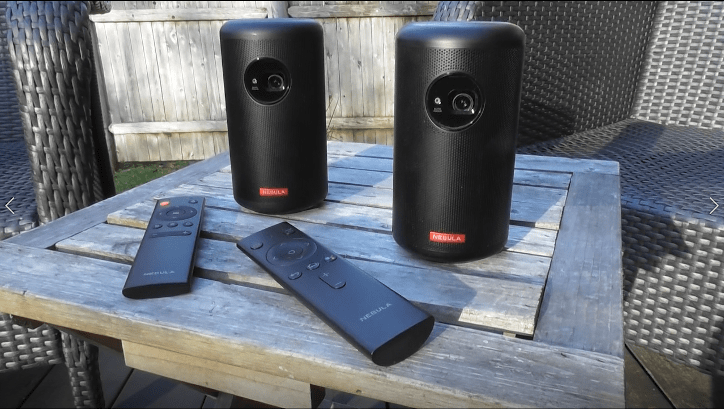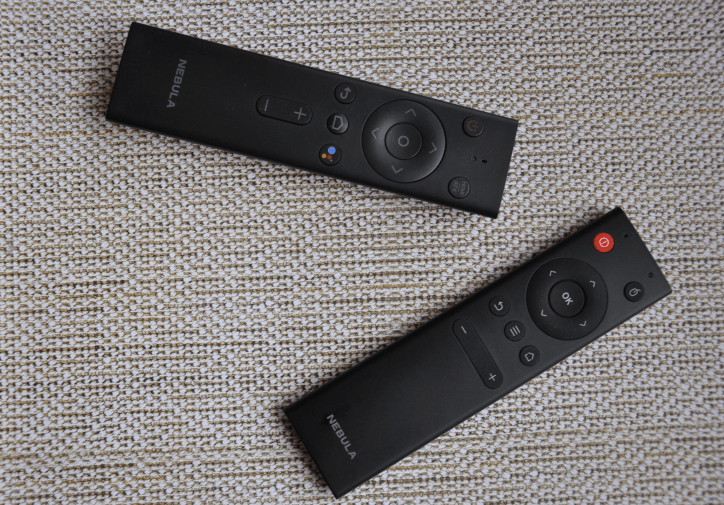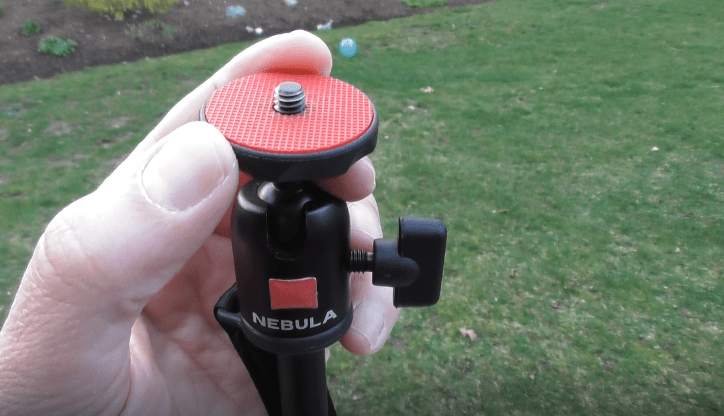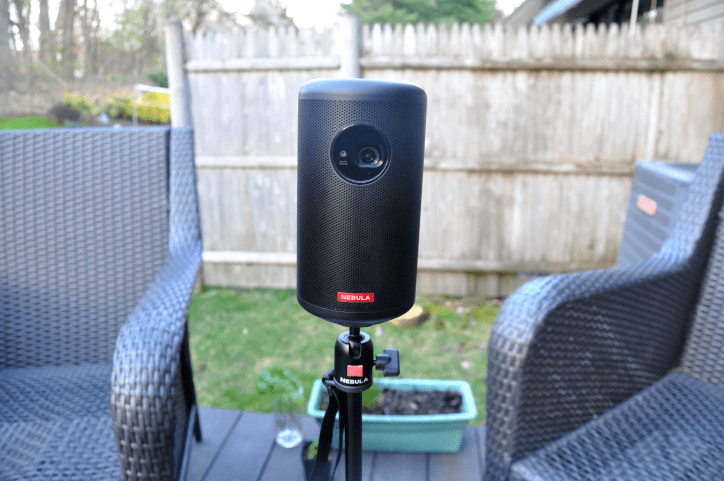The Nebula Capsule Max debuted in August 2019 as a follow-up to the Nebula Capsule II, and quickly got traction in the mini projector market for its portability and picture size.
Unlike it’s sibling, the Max ran on Android software, but came with a pre-installed workaround to stream Netflix via a mobile app.
The Nebula Capsule Max bears a lot of similarities to its masterful sibling, the Nebula Capsule II. It has 720p resolution and with a brightness of 200 ANSI lumens, making it possible to start using at dusk or nighttime conditions.
In 2024, competitors like XGIMI’s Mogo Pro 2 offer better picture resolution at 1080p with HDR10. The Mogo 2 Pro’s brightness is rated at 400 ISO lumens, which delivers a similar experience to the Capsule Max. However, the Mogo 2 Pro is currently priced at $369.99.
The Max has a very solid build, it doubles as a Bluetooth speaker and it’s generally a very good portable projector at its price point. If I had to pick between the Capsule Max or Capsule II? I like the Nebula Capsule II better — mainly because of its Android TV software and Google Assistant.
Testing the Nebula Capsule Max
I have spent the past few months using the Nebula Capsule Max indoors, outdoors and all around. And I’ve been regularly using the Capsule II for close to a year.
While using the Max, I also tested out the Nebula tripod. So I will compare it to using a tripod made for DSL and video cameras. I use a portable projector about every other week for a movie night.
I prefer portable projectors because they are easy to set up. And I’m a huge fan of watching older movies on The Criterion Channel and some newer titles on Netflix, Amazon Prime and Hulu.
Buying advice on portable projectors
One stumbling block for people who want to buy a projector is price.
You can find recommendations for cheap projectors that cost as low as $50 on Amazon and elsewhere. But the problem with virtually all of these so-called cheap projectors is that the lumens — or amount of light it emits — is way too low.
And with some of these cheaper models, the colors tend to bleed or become hazy. The bottom line is if you’re serious about HD picture quality and somewhat decent audio, a realistic starting price is around $500.
Nebula Capsule Max: The Basics
- HD Picture Resolution (720p)
- Android software
- 200 ANSI-lumens
- Auto Focus
- Doubles as 8W Bluetooth speaker
- 100+ inch screen
Both the Nebula Capsule Max and Capsule II have HD Picture Resolution at (720p) that is bright and crisp in the dark at about 100 to 120 inches. I set up my projector between 8 and 10 feet from a wall or screen.
The Max has 200 ANSI-lumens just like the Capsule II. That means if you’re outdoors, you’ll want to start using the projector at dusk. When you’re inside, just find a somewhat dark room.
Pitch black is going to give you an optimal experience.
Audio experience
The audio is surprisingly good, especially when you consider that the Capsule Max — and the Capsule II — is the size of a pint glass.
A recent screening of the World War I movie ‘1917’ is a good example. During the movie, you could hear the faint buzzing from flies circling a dead horse blending seamlessly with footsteps and dialogue. I would expect that kind of audio from a theater grade setup.
The Max has an 8W Bluetooth speaker. The Bluetooth speaker works like any other standalone speaker. Streaming music services such as Spotify and Tidal work well. The 8W speaker on the Capsule Max and Capsule II is larger than what you’ll find even in some home theater projectors.
The other thing that really helps in the audio department is the fact that the Max and Capsule II are both very quiet projectors. You barely notice the fan when it’s running, which can be a problem with projectors with brighter, hotter light sources.
Setup and picture resolution
Auto-focus with keystone correction is one of my favorite features. It has been on pretty much every Anker projector that I’ve tested going back to the Nebula Mars II. So you don’t have to worry about being in focus or figuring out what angle the image should be projected on your wall or projection screen.
This may not seem like a big deal. But cutting down on your setup time really makes the projector experience a lot more enjoyable.
You’ll really notice that difference if you’re the type of person who moves your projector around a lot like I do. During the summer, I watch movies outside as much as I can. But the weather might force me indoors. Or maybe there’s too many mosquitoes out one night.
You can also adjust the focus or the keystone correction on the Max manually. But it’s nice when you don’t have to deal with it — and I think it’s a real strength for the Capsule Max and other Anker projectors that I’ve tested.
Nebula says the Capsule Max and Capsule II can project up to 100 inches. I used an inexpensive OWLENZ projector screen for testing out the Max and Capsule II. Both projectors filled out the screen without sacrificing picture quality.
Nebula’s Capsule Max vs Capsule II: The Differences
The Nebula Capsule Max is powered with a DC power input. The Capsule II power adapter is USB-C. Otherwise, the two projectors have all the same USB and HDMI ports.

There’s a USB port for flash drives or external storage if you have a movie collection you want to tap into. You don’t need to be connected to WiFi if you wanted to stream movies off of a hard drive or flash drive.
Both projectors have an HDMI port. So you can plug in a Roku or Fire Stick. You could plug in your laptop. I plugged an XBOX 360 because … well, no, I never upgraded after that. The buttons on the top of the projector are the same on the Max and Capsule II. These buttons mimic what’s on the remote control. There’s volume. Navigation buttons. A return and confirmation button.
By the way, before you even use any Anker projector for the first time, you definitely want to charge it up to 100 percent. The battery on both projectors typically last about 2 and a half to 3 hours, but you really need to charge the projector before the first time you use it or you won’t get the same result.
Remote control
The Capsule Max’s remote is light; it’s made of a hard plastic that’s pretty solid. The buttons have a rubberized finish.
The remote controls power, navigates through the app menu, and most importantly, adjusts the volume. It’s powered with a pair of lithium coin-shaped batteries which come with the projector. These are CR2032s, which are very common.

The Capsule II remote is all plastic including the buttons for power, HDMI, the home button and volume. The batteries on this one are two triple As. There is a button that triggers Google Assistant.
The software: Android vs Android TV
The Capsule Max has Android software, which shouldn’t be confused with Android TV software.
And software is where the Max and Capsule II really diverge. The Android TV software in the Capsule II is the same one you’ll see in the NVIDIA Shield, a number of smart TVs. And since the Capsule II came out, there are a couple of projector manufacturers that are either already using Android TV, or have plans to use them.
Google Assistant can execute searches for movies (and will include results on your Plex server). You can also search for the schedule for next Red Sox game, or weather forecasts.
The Max has a version of Android software that isn’t too different from what you see on mobile devices. I’m not a big fan of this kind of software because if you don’t have to take a very deep dive into its app store before you run into occasional problems.
Certain apps can be clunky and lock up at times. The biggest issue for most people is the picture quality from the software isn’t as crisp as using a streaming stick.
So for example, the Max does support Netflix. But if you compare the picture quality on the Max’s app to plugging in a Fire Stick or a Roku into the projector’s HDMI port, there’s a pretty noticeable difference.
And certain apps on the Capsule Max’s software such as Plex or Hulu had a gauzy overlay on the picture.
Plugging in a Roku Streaming Stick or a Fire Stick easily solves the software problem on the Max. The only downside now is that you’re using two remotes.
You can power a streaming stick through the Max’s USB port, but that can come at the expense of shorter battery life if the power cord is not attached to the projector.
Having Android TV software is one of the main reasons the Nebula Capsule II is a better projector than the Max. You can tap into just about every major streaming service whether it’s Hulu, Fubo, YouTube TV or Disney+.
The Capsule II is also great for streaming a home movie collection from Plex. There’s free live TV platforms such as Pluto TV and if you have a TV antenna with a HDHomeRun or Tablo connected in your home, you can even watch free over-the-air channels. The Capsule II also has a built-in Google Chromecast for streaming personal photos, videos and some streaming apps.
Using Netflix
One thing that’s important to point out: you can watch Netflix on the Capsule II. But it takes a bit of work. Anker says that due to Netflix’s policies, the company only certifies devices with at least 1 million units in production.
Anker addresses the lack of Netflix on the main menu by side loading the app through its mobile app. Just follow the instructions on the app to add Netflix to the projector. When you’re done, you’ll have an N icon at the top of the app.
Once you have Netflix on the screen, you can go back to using the regular remote control or the mobile app to navigate around.
The Netflix situation isn’t ideal. But if you start looking at other mini projectors, you’re going to pretty much run into the same situation. The reason is basically because Netflix has a fairly strict certification process.
Liner Notes: Is the Nebula tripod worth it?
The Nebula tripod is 15.7 inches tall when fully extended, and it comes with a travel pouch. It can be folded down to 10.2 inches, and you can even disassemble it if you’re really trying to minimize the footprint inside a suitcase or backpack.
The tripod is made of alloy and feels sturdy. Because of its size, you can definitely set up your projector faster than with a standard tripod used for a DSL camera.

The part of the tripod that really helps with a faster setup is the ball-joint that has a 360 degree range. It’s easier to fine tune the angle of the projector compared to tripods that just tilt up and down and left to right.
If you already have a tripod that swivels then you’re probably fine with that. A number of Nebula’s mini projectors come with a tripod fitting on the bottom, including the Max, Capsule II and Mars II. If you don’t have a tripod and need some elevation, then grab a few books. Just make sure whatever you use is really solid. You don’t want your projector to take a spill.
When investing in a portable projector like the Capsule Max, it’s always a good idea to get a tripod so because it makes lining up your image with the screen much easier.

Very thank’s from Brazil
Thanks so much for this review. I’m wrestling with buying one of these and nowhere (incl Nebula website) could I find this comparison, in fact their website doesn’t even include the Max.
Very good information, thanks.
Can you charge the II via the USB-C and play it at the same time?
Thanks for the helpful comparison. Do both projectors work well with Criterion and – if I travel internationally – with VPN?